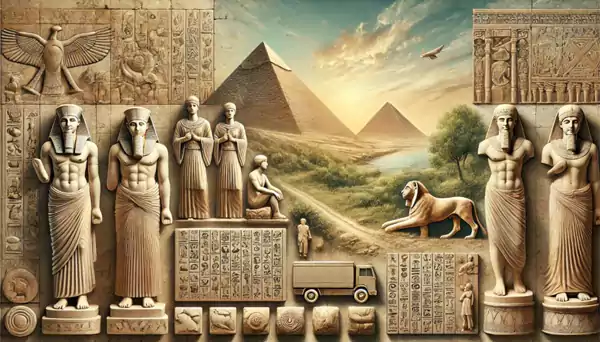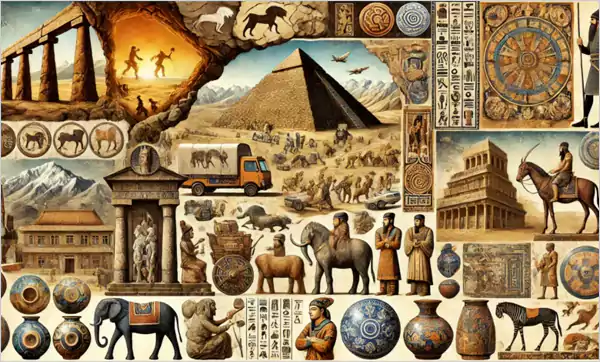Ancient Artz has always been an integral part of human civilization. Its traces can be seen in cave paintings, monuments, sculptures, intricate pottery, and other forms. Some of them are still beyond human understanding and visualization.
These artworks and their defining characteristics provide a deep dive into the historical, cultural, social, and religious norms of ancient people. Their rich legacy continues to shape the art forms and skills of the present generations.
In this article, we’ll try to go back in time to explore the beauty of these ancient artworks, their living artifacts, some of the most influential civilizations, and their impact on modern art and culture.

It is believed that the roots of ancient artz emerged more than 40,000 years ago from cave paintings across Europe, Asia, and Africa and later spread to other parts of the world. Petroglyphs, or rock carvings, were also common forms in the early days of human civilization that were a combination of survival and spirituality.
Initially, art was a powerful medium to depict stories, religious expressions, and communications, preserve culture and values, represent events and lifestyles, and signify the glory of civilization through symbolism. Some common methods used during the ancient period were paintings, sculptures, pottery, architecture, and textiles.
Read the subsequent section to get more detailed information in this regard.

Ancient Artz is a rich mosaic designed by various civilizations from different corners of the world. They used various techniques, styles, and themes to present their culture, beliefs, and diversity. Here are some of the most powerful and prominent civilizations and their never-ending contributions to the artistic development of the world:
Mesopotamia is considered the foundation of civilization, with some of the earliest known art forms, including the Akkadians, Assyrians, Sumerians, and Babylonians. Over time, many artifacts, such as stone reliefs, statues, and cylinder seals, have been found. The work was highly inspired by religious themes, with gods and kings’ portraits to depict their glory and power.
The Stele of Hammurabi, a 7-foot-tall basalt monument, is one of the most significant artifacts of this civilization. These people were also utilizing the art for communication and recording laws, events, and spiritual works.
The art of this civilization is well-known for its bold lines, intricate designs, and symbolism. These people combine art and scripts to record events, honor their gods, and decorate tombs. The paintings and carvings were highly inspired by the story of the afterlife accompanying pharaohs and nobles, immortalizing them in jewelry and giant stone statues.
The Great Sphinx of Giza, a limestone statue, is a great example of their craftsmanship and artistic richness. Also, in the cave of the Valley of the King, you can witness scenes from ancient Egyptian life.
Flourished in the regions of India and Pakistan, it is one of the major ancient civilizations in the world. Their figurines, jewelry, pottery, seals, and other artifacts made from terracotta and bronze have a unique value and charm.
They represent Hindu deities, animals, and everyday people with their advanced crafting techniques. They have beautiful seals that were used for trade as well as religious purposes. Due to their urban planning and sophisticated engineering techniques, the Indus Valley is still considered the most advanced human civilization in history.
The art of ancient Greece gets the credit for the foundation of artistic history and culture in Western civilization. These people represented ideal art forms in their work with high intricacy to proportion, balance, and beauty. Their art of sculptures was adorned with realism and anatomical accuracy, as can be seen in the Venus de Milo, David of Michelangelo, and Laocoön Group sculptures.
Greek pottery was filled with miniature designs and scenes from mythology. Also, their architecture was unprecedented, as illustrated in several temples and theaters, such as the Parthenon in Athens.
Ancient Chinese art was deeply inspired by philosophy, nature, spirituality, and religion, particularly Confucianism, Taoism, and Buddhism. They were the master of calligraphy, ink wash painting, silk painting, and sculpture. The balance, simplicity, and harmony of ink strokes on the paper were their unique skill.
One of the most astounding discoveries of Chinese art is The Terracotta Army, showcasing thousands of warriors protecting Emperor Qin Shi Huang.
Roman art is highly inspired by Greek culture, but they added their grandeur and practicality to it. They built huge public buildings, monuments, and portraits to glorify the Roman Empire and military conquests and remind their achievements. Frescoes, mosaics, statues, and busts were used to adorn the public and private spaces and floors and walls of homes, showcasing mythological references, landscapes, and daily lives.
The Rock Art found in the Sahara Desert of Africa is a notable example of African art. It is believed to be one of the earliest art forms of human history, depicting early life, hunting scenes, and spiritual practices.
Their wooden sculptures and masks still have huge significance due to their craftsmanship and spiritual symbolism as they represent ancestors, gods, and spirits. These pieces also throw light on the modern art movements around the globe.
The Mayan and Aztec civilizations became popular for their pre-Columbian American art, representing their rich creativity and knowledge of astronomy. Mayans’ work was highly dedicated to the gods and celestial events as visible in their murals and carvings, while Aztec art was focused on the dominance of their empire.
Olmec Colossal Heads, the giant stone sculptures representing rulers, show the impressive artistic history and stone-carving skills of these civilizations.
Ancient Indian art mainly holds religious references to Hinduism and Buddhism. They had stunning architectural skills visible in many Stupas (dome-shaped shrines) and South Indian temples built during the period. Carvings and statues of deities and intricate sculptures of gods and goddesses reflect a deep spirituality among these people. Ajanta Caves, adorned with murals, are a fine example of early Indian artistic beauty.
Some small civilizations and arts include The Parthenon, Pompeii, and Herculaneum of the classical world; Byzantine Art, Romanesque Art, and Gothic Art of the medieval era; the Italian Renaissance; the Baroque Period; the Enlightenment and Neoclassicism, etc. They also gave notable contributions to the ancient art and its flourishment.
When it came to the modern era, we also saw several movements such as impressionism, post-impressionism, abstract art, contemporary ancient artz, and others that evolved the art, its concepts, techniques, and materials over time.
Various unique techniques and materials used by ancient artists to create their masterpieces that are still adorned for their richness are as follows:
The artists used chisels and hammers to create sculptures, inscriptions, and reliefs in stone. This reflects their invaluable skills and patience, which are clearly visible in many living monuments, statues, and sculptures.
The paintings were done with the help of natural pigments derived from minerals, plants, and insects. They can be seen in cave paintings, Fresco paintings in Rome and other cultures, and papyrus scrolls in Egyptian style to create portable art.
To create jewelry, statues, and weapons, ancient civilizations mainly used gold, silver, and bronze. The Greeks and Romans also used the lost-wax casting technique to create wax models.
In ancient art, decorated vases and bowls were so common. Many civilizations used clay sculpture to present stories or honor deities on clay. These pots were also glazed with colors to make them stunning and preserve the clay.
Apart from them, calligraphy and architectural work, including monuments, empires, and temples, rock art, carvings, miniatures, etc., were also famous art techniques and practices followed during the ancient period among different civilizations.
The techniques, styles, and philosophies used in the ancient period had a great influence on shaping contemporary art, culture, architecture, and education. Their legacy is continued to be preserved and studied by humans, as can be understood below:
Ancient art has given spark to countless art movements throughout history, including the Renaissance, the Baroque Period, the Enlightenment and Neoclassicism, and Modern Art. The initial movements gave birth to the Greek and Roman art forms, while modern art movements such as minimalism found their roots in the simplicity and symbolism visible in Egypt and ancient China’s culture.
Various museums, universities, and cultural organizations such as The British Museum, England, the Louvre Museum, France, and The Metropolitan Museum of Art, New York, etc. are putting their efforts into preserving the ancient artz. Many archaeologists discover new artifacts to find the connection with ancient civilizations and get a deeper understanding of their unbelievable artistic expressions.
By studying these art forms, we got to know about our ancestral civilizations, their lifestyle, cultural and religious beliefs, and much more. It sets the building block of art history and shows its evolution.
Additionally, the ancient artz has also played an impactful role in religious movements and development through sacred symbolism, deities, temples, and shrines.
Ancient Artz opens the doors to the past world of the flourished artistic endeavors in the early era. From the intricate carvings of Mesopotamia to Chinese calligraphy, the afterlife depiction of Egyptians to the urban planning of the Indus Valley, every civilization holds a unique value in art history. All of them played an immortal role in directing modern art forms.
The enduring relevance of these ancient masterpieces will continue to hold its importance in crafting art, understanding the ancient culture, and inspiring the future generation to eternity.
Ancient art was mainly derived from the themes of religion, power, the natural world, daily activities, events, values & beliefs, fiction, spirituality, etc.
Many works were preserved due to their durable materials such as stone or metal and climatic and geographical conditions. While others were preserved by continuous cultural reverence and care over time.
Some of the widely known and unique artworks include the Great Sphinx of Giza, the Terracotta Army, the Stele of Hammurabi, the Colosseum in Rome, the Venus de Milo, the Ajanta Caves, etc.
Artist in the ancient period used materials like stone, clay, metals, and natural pigments to craft their work.
